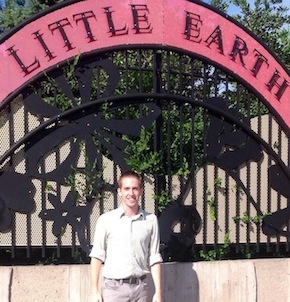By Larry Di Giovanni
Note: This is the second piece of a four-part series examining the Geisel School of Medicine’s long-standing work in primary care with American Indian and Alaska Native communities. Read parts one, three, and four for more.
Liam Guerin, Geisel School of Medicine second-year student who participated in the school’s alternative spring break in Minnesota in March, spent part of his summer conducting a health survey within The Little Earth of United Tribes, a housing development of approximately 1,000 Native American residents in Minneapolis. As one of the survey interviewers, Guerin asked residents “about their health from every angle – physical, spiritual, emotional, and chemical.”

One of the survey goals is to develop data from 400 participants that will be used to produce grant funding connecting Little Earth residents with new resources for improved community health. An example would be a program for traditional Native American spiritual healing. Survey findings will also help to foster “talking circles” that keep residents connected to ongoing issues.
Guerin described his interviews with Little Earth residents as “very intense.” He spent about an hour with each resident, and interviewed 35 in one week.
“It’s one thing to read stories about chemicals that are affecting different urban American Indian populations and reservation populations,” Guerin says. “It’s another thing to talk with people directly who have lost loved ones, and who are themselves dealing with addiction. The survey is part data gathering but it’s also part counseling almost. I have found myself using a lot of the counseling skills learned from my first year of medical school at Dartmouth.”
Primary care role models: Patel, Erdrich encourage service to Native Americans
For Geisel students Cassandra Rendon and Guerin, both inclined toward primary care careers in service to Native Americans, two role models each mention are pediatricians Sandeep Patel, MD, and wife Angie Erdrich, MD, a 1987 graduate of Dartmouth College and 1994 graduate of Geisel. Sandeep, who lives with Angie in Minneapolis, works a two weeks on, two weeks off schedule for the Quentin N. Burdick Health Facility in Belcourt, N.D., which serves the Turtle Mountain Band of Chippewa. Angie works for the Indian Health Board of Minneapolis, a Federally Qualified Health Care Center just four blocks from Little Earth of United Tribes housing.
Patel and Erdrich host part of the Minnesota Alternative Spring Break in their home. “I received a lot of advice and encouragement from them during separate conversations,” says Rendon, who is a distant cousin of Erdrich and whose aunt, Paula Bercier, is a family physician for the Turtle Mountain Band.
It’s one thing to read stories about chemicals that are affecting different urban American Indian populations and reservation populations. It’s another thing to talk with people directly who have lost loved ones, and who are themselves dealing with addiction.” Liam Guerin, Geisel Student
Guerin recently witnessed Angie Erdrich’s services in action at Little Earth, where she provided support to a Shakopee mobile tribal clinic providing immunizations. Erdrich also takes spring break students on a tour of Little Earth during their weeklong experience. Service facility that prioritizes use of tribal members as health care providers.
“For three years now we’ve had the spring break students spend the night during their trip,” Patel says. “We do sort of a lunch thing at our home to start the week, and then at the end of the week, they crash at our house. They are wonderful to have around.
“The students have so much energy and they’re interested in serving, and that is what Angie and I believe medicine should be about.”
The luncheon is a community party that includes Native American friends who share language and culture. This past spring, those attending included Angie’s older sisters: Louise Erdrich, DC ’76, a best-selling author, and poet/author Heid Erdrich, DC ’86, both who live within two blocks of her.
An Ojibwe woman, who is a sister to a nurse Erdrich works with, was so touched by Guerin’s ability to play a Native flute she had made, that she gave it to Guerin as a gift.
“It was wonderful that she did that,” Erdrich says. “People are very interested in the Geisel students when they arrive. They like the idea that someone has come all this way to learn about northern tribes and help them.”
Before moving to Minneapolis in 2009, Patel and Erdrich spent the first 12 years of their careers mainly on northern tribal reservations, including service to the Oneida tribe of Wisconsin, the Navajo Nation, the Sisseton Whapeton Oyate Band of Dakota, and the Turtle Mountain Band of Chippewa in North Dakota, where Erdrich is an enrolled tribal member.

Patel says any amount of primary care service in American Indian-populated areas -- whether one or two months, or one or two years – “is a huge bonus” for patients receiving care.
“My husband and I are very partial to spreading the word about North and South Dakota because the native people here are so underserved,” Erdrich says. “I’m sure Sandeep wouldn’t toot his own horn, but it’s amazing what he does in a rural area. His patient load is so complex.
“It would be a wonderful experience for a medical student to follow him and learn what he does. Because he’s the only pediatrician (at the Quentin N. Burdick Health Facility), he has to take care of children with kidney transplants, liver transplants, cancer, genetic disorders, and cochlear implants. It’s really amazing. As a doctor, he’s their bridge to specialists, and since there aren’t many here, some patients are referred to places like The Mayo Clinic.”
About the author:
Larry Di Giovanni has written about higher education, health care and Native-American communities including K-12 education for 20 years. He lives in Athens, Ohio.